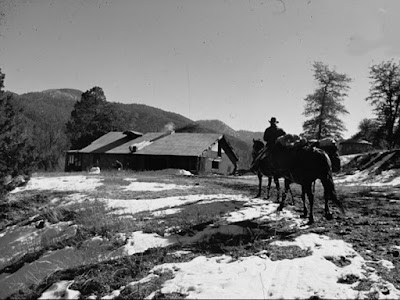One of the most beautiful areas of the Superstition Wilderness Area at Christmas time is the Reavis Valley.
 |
| Going home for Christmas to the old Reavis Ranch. |
Several years ago around Christmas time a group of us decided we would visit the ranch on Christmas Eve. This visit I will never forget. Tom Johnson, the principal of Superstition Mountain Elementary School (SMES), and I rode up to the Reavis on December 23 spending the night and riding out on Christmas Eve December 24.
Another group had spent the night in the ranch house and rode out that morning. We had the place to ourselves. We knew it would be quite cold before morning, probably below freezing.
As soon as we unsaddled the horses, fed them and put them in the corral, we went about gathering firewood for the night. We gathered wood far and near because so many campers were using the Reavis Valley. To be honest firewood was extremely scarce in the immediate area. Eventually we gathered enough firewood for the night. The scarcity of wood for campfires was what eventually led to the downfall and destruction of the old ranch. Lazy campers started burning the ranch house itself. They burned the old ranch piece by piece until it was nothing more than a skeleton of what it once was.
Then sometime during November of 1991 somebody built a fire in the attic and caught the roof on fire. If the ranch house was full of people on a real cold night, campers would take a sheet of tin into the attic and build a fire on it.
Once the sun went down we moved inside. We built a fire in the old fireplace and turned on our lantern. As our eyes became accustomed to the light we could still see the old brands in the fireplace mantel and on the side rails.
I could envision the room from an earlier visit when Floyd Stone and his wife Alice lived here. My wife and I had sat several times in this room filled with Native American pottery, Navajo rugs, and Papago baskets.
I remembered the Western leather furniture Stone had hauled some 12 miles over the Reavis Ranch road from the Apache Trail. This certainly was a trip of reminiscence for me as I describe what this room had looked like when Floyd Stone and his wife lived there in the 1950s and early 1960s.
As Tom and I sat around the giant hearth with a roaring fire I began to recall some of the stories about the Reavis. I told him the story about old Elisha M. Reavis, the first settler in this valley. I told him about the fifteen-acre truck garden he put in and then sold his vegetables throughout the Central Mountain region of central Arizona Territory. He became known as the “Hermit of Superstition Mountain.”
Reavis settled in the valley about 1874 and died about four miles south of the Reavis Ranch in April of 1896.
There are many stories about Reavis and what he did before moving to the valley. He served as a Deputy United States Marshal in the McDowell Precinct. He raised and trained pack animals up on the Verde River above Fort McDowell and he assisted the Army occasionally as a packer. Hopefully someday, somebody will write a book about this very interesting citizen of Arizona.
He was born in Beardstown, Illinois, in 1829. He attended college and upon graduation he moved to California and taught school. Gold prospecting interested him more than teaching so he became a prospector and a miner. He was married and had a daughter before he left for Arizona Territory the last time in 1869.
Tom and I sat around and talked about the old Reavis and the many people who had lived in this beautiful isolated valley. These people included Elisha Reavis and John J. Fraser, a Canadian. Fraser sold the homestead to William J. Clemens and his two sons Mark and Twain. Floyd Stone was John A. “Hooley” Bacon’s son-in-law. Stone married “Hooley’s” daughter Alice. After several stories Tom had his history lesson for night.
As we prepared for sleep we found a poem written by an Apache Junction Firefighter entitled “The Night Before Christmas At The Old Reavis Ranch.” The poem mentioned the fireplace, the brands on the mantle, the raccoons in the attic, and several other localized events and things associate with the old isolated mountain ranch.
We read that poem several times before turning in. The poem became one of the most memorable things to ever occur for me in this mountain wilderness. I didn’t have a pen and could not copy the poem down. Also I didn’t have the heart to remove it from the old Reavis Ranch. We have always hoped the fireman who wrote it would come forward with it because I would love to print it in the paper and share it with the world. This poem was so special to us on that night. The next day we packed up and headed home. We both needed to get home to our families by Christmas Eve.
In closing I would like to wish all of you a Merry Christmas and a Happy New Year. God bless and thank the service men, policeman and fireman who are keeping us safe and secure this holiday season.


















